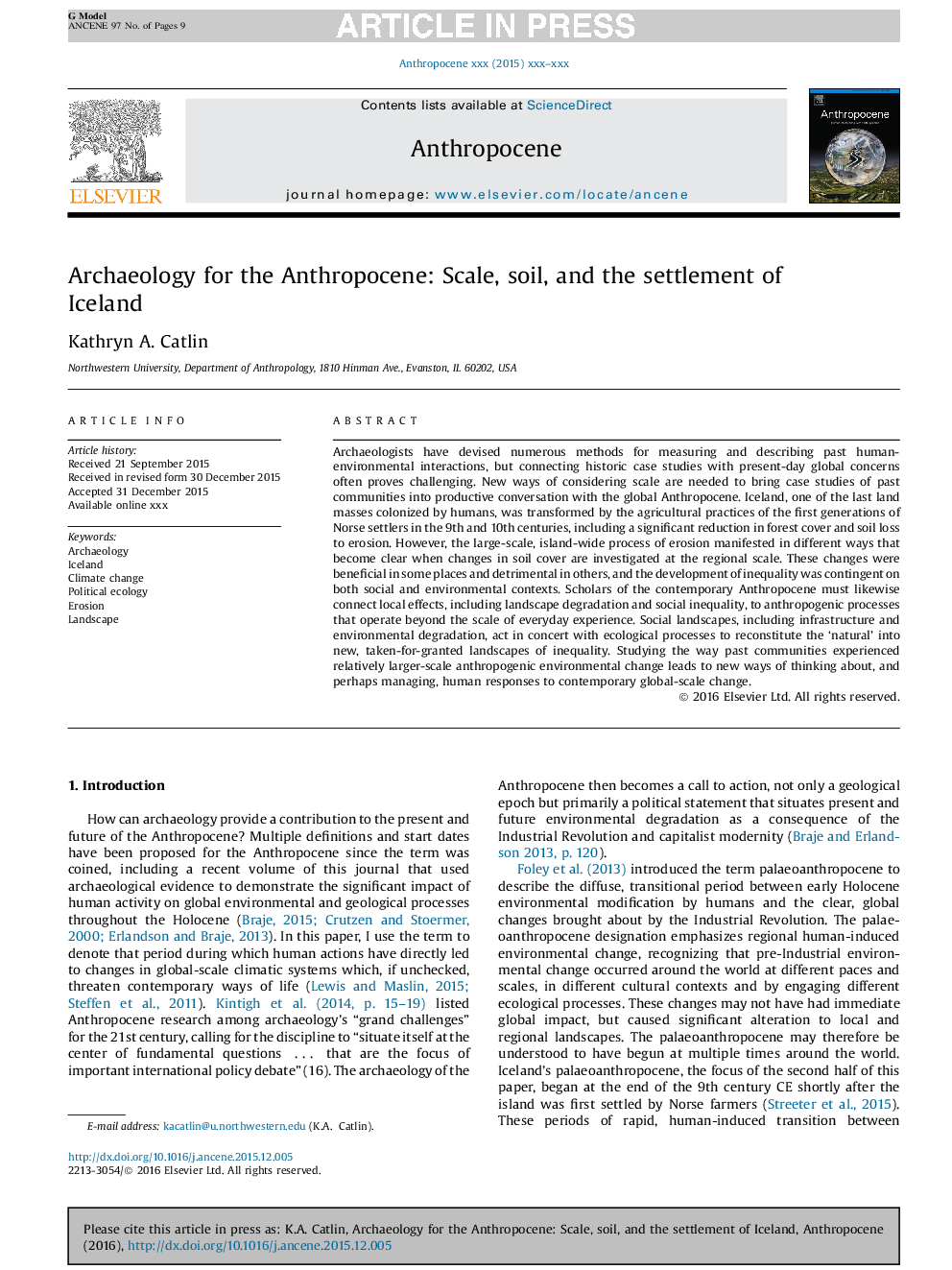| کد مقاله | کد نشریه | سال انتشار | مقاله انگلیسی | نسخه تمام متن |
|---|---|---|---|---|
| 5755069 | 1621510 | 2016 | 9 صفحه PDF | دانلود رایگان |
عنوان انگلیسی مقاله ISI
Archaeology for the Anthropocene: Scale, soil, and the settlement of Iceland
ترجمه فارسی عنوان
باستان شناسی برای آنتروپوکسین: مقیاس، خاک و حل و فصل ایسلند
دانلود مقاله + سفارش ترجمه
دانلود مقاله ISI انگلیسی
رایگان برای ایرانیان
کلمات کلیدی
باستان شناسی، ایسلند، تغییر آب و هوا، محیط زیست سیاسی، فرسایش، چشم انداز،
ترجمه چکیده
باستان شناسان روش های متعددی را برای اندازه گیری و توصیف تعاملات میان انسان و محیط زیست پیش بینی کرده اند، اما اتصال مطالعات موردی تاریخی با نگرانی های جهانی امروز اغلب به چالش کشیده می شود. روشهای جدیدی برای اندازهگیری مقیاس مورد نیاز است تا مطالعات موردی جوامع گذشته را به گفتگوهای مولد با آنتروپوسن جهانی بسپارند. ایسلند، یکی از آخرین توده های زمین که توسط انسان ها مستعمره شده بود، توسط شیوه های کشاورزی نسل اول مهاجران نروژ در قرن 9 و 10، از جمله کاهش قابل توجهی در پوشش جنگل و از دست رفتن خاک به فرسایش تبدیل شده است. با این حال، روند بزرگ فرسایش در مقیاس بزرگ، در سراسر جزیره به روش های مختلف نشان می دهد که زمانی که تغییرات در پوشش خاک در مقیاس منطقه ای بررسی می شود. این تغییرات در بعضی از نقاط مفید بود و در دیگر کشورها زیان آور است و توسعه نابرابری در شرایط اجتماعی و محیطی متکی بود. محققان آنتروپوسن معاصر باید به طور مشابه اثرات محلی، از جمله تخریب چشم انداز و نابرابری اجتماعی، به فرایندهای انسان شناسی که فراتر از مقیاس تجربیات روزمره عمل می کنند، متصل شوند. مناظر اجتماعی، از جمله زیرساخت ها و تخریب محیط زیست، با هماهنگی با فرآیندهای زیست محیطی، به منظور بازسازی "طبیعی" به مناظر جدیدی که برای به دست آوردن نابرابری گرفته شده اند، عمل می کنند. مطالعه جوامع گذشته جوامع دارای تغییرات محیطی انسانگرا نسبتا بزرگتر منجر به راه های جدید تفکر در مورد و شاید مدیریت پاسخ های انسانی به تغییرات معاصر جهانی می شود.
موضوعات مرتبط
مهندسی و علوم پایه
علوم زمین و سیارات
علم هواشناسی
چکیده انگلیسی
Archaeologists have devised numerous methods for measuring and describing past human-environmental interactions, but connecting historic case studies with present-day global concerns often proves challenging. New ways of considering scale are needed to bring case studies of past communities into productive conversation with the global Anthropocene. Iceland, one of the last land masses colonized by humans, was transformed by the agricultural practices of the first generations of Norse settlers in the 9th and 10th centuries, including a significant reduction in forest cover and soil loss to erosion. However, the large-scale, island-wide process of erosion manifested in different ways that become clear when changes in soil cover are investigated at the regional scale. These changes were beneficial in some places and detrimental in others, and the development of inequality was contingent on both social and environmental contexts. Scholars of the contemporary Anthropocene must likewise connect local effects, including landscape degradation and social inequality, to anthropogenic processes that operate beyond the scale of everyday experience. Social landscapes, including infrastructure and environmental degradation, act in concert with ecological processes to reconstitute the 'natural' into new, taken-for-granted landscapes of inequality. Studying the way past communities experienced relatively larger-scale anthropogenic environmental change leads to new ways of thinking about, and perhaps managing, human responses to contemporary global-scale change.
ناشر
Database: Elsevier - ScienceDirect (ساینس دایرکت)
Journal: Anthropocene - Volume 15, September 2016, Pages 13-21
Journal: Anthropocene - Volume 15, September 2016, Pages 13-21
نویسندگان
Kathryn A. Catlin,
